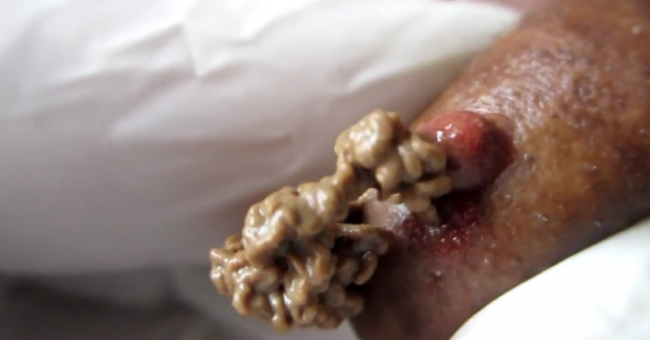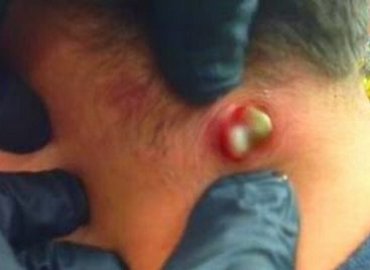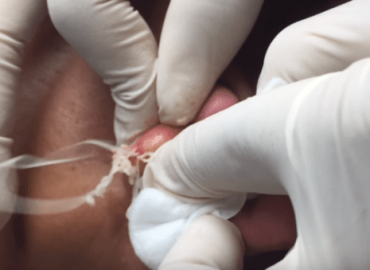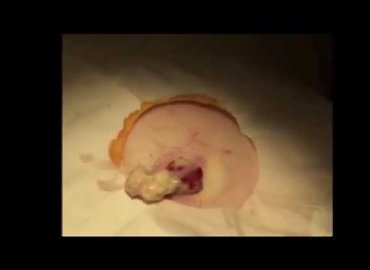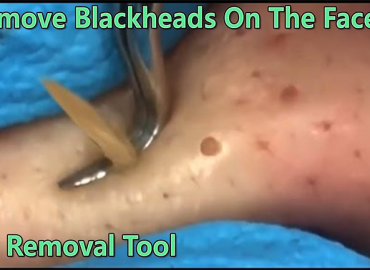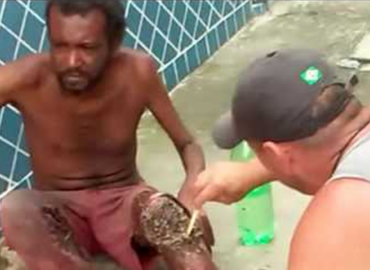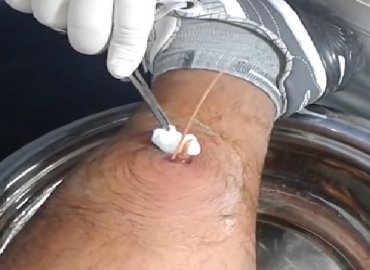Here you can see an old sebaceous cyst and from it its content keratin oozing out, this is the same keratin of which our skin layers, hairs and nails are made up of, it is actually a kind of protein, it has a particular smell due to presence of some sulpher content…
Don’t pop pimples that are big, red, or sore. This could worsen your pimple by sending bacteria deeper into your skin. Popping a pimple this big will almost definitely lead to a scar. Only a pimple with white pus is ready to pop.
Visit a dermatologist. Dermatologists can determine the best way to treat your acne. They can prescribe creams that will eliminate your pimples. There are also several procedures they can perform that can treat severe breakouts.
The most commonly prescribed dermatologist treatment is a topical cream, rubbed on the pimples, that will remove oil from the skin and kill acne-causing bacteria.
For red, swollen pimples an oral antibiotic, hormonal birth control, or isotretinoin might be prescribed.
Large acne cysts can be removed by dermatologists through drainage and extraction, in which they remove the cyst and drain out the pus.
Your dermatologist can safely lance the pimple with a pin. This is a technique that should only be done by professionals.
Laser therapies and chemical peels can treat the underlying causes of acne, although they will not remove current cysts.
Limit pimples by washing regularly. Pimples are caused by sweat sitting on your face. Anytime you sweat, wash your face gently with lukewarm water to remove dirt and grime. Do not be harsh or scrub, just wash off sweat.
Scrubbing roughly can worsen acne.
Do not use rough cleaners, like astringents, toners, or exfoliants.
Prepping Your Hands and the Pimple
Wash your hands. This will prevent bacteria from spreading to your face. Wash thoroughly, especially underneath the nails, and use plenty of soap and warm water. You’ll want to avoid touching the pimple with your finger nails, but just in case you do, having them clean will reduce the likelihood of irritation and infection.
Consider using a fingernail brush to get dirt out from under your fingernails.
Cover your hands. Put on disposable gloves just before you’re ready to pop the pimple. Not only will this put a barrier between any remaining bacteria on your fingers (and in your fingernails) and your skin, but it will also prevent the sharp edges of your nails from impacting the pimple.
If you don’t have disposable gloves, you can cover your fingers with clean tissues.
Clean the skin surrounding the pimple with a face cleanser or rubbing alcohol. Apply cleanser to a cotton ball and spread it. When you pop the pimple, you’ll be opening the skin, creating a way for bacteria to enter. The pimple will heal faster if you don’t give bacteria a chance to settle in and create a new or worse infection.
Don’t scrub the area too hard, or you’ll irritate it further. Gently cleanse the area, rinse it with warm water, and pat it dry with a towel.
Popping a Pimple with a Pin
Sterilize a pin with fire. Use a match or lighter to heat up and sterilize the pin. Expose every bit of the pin to fire for several seconds to kill off any bacteria.
Allow the pin to cool. Give the pin at least a minute to cool down. It should not be painfully hot when you use it to pop your pimple.
Sterilize everything with rubbing alcohol. Apply rubbing alcohol to the pin, to your hands, and to the zit. Be sure that everything involved in the procedure is sanitized with rubbing alcohol.
Hold the pin parallel to your face. You do not want to point the pin toward your face. Instead, you should hold it along your face, so that when you poke your pimple it won’t penetrate anything but the very tip of the pimple.
Pierce the white tip of the zit. Do not touch anything but the white part of the zit. Penetrating the red part of the pimple will cause scarring. Instead, run the pin through the very tip of the pimple, so that it goes through one end and out the other.
Pull up with the pin. The pin should have penetrated the length of the white tip. Pull the pin out, away from your face, so that it ruptures the white tip when you remove the pin from the pimple.
Gently squeeze around the white top. Do not squeeze the white top itself. Instead, squeeze the perimeter of the pimple so that it pushes out the pus. Consider squeezing with a cotton swab to avoid doing additional damage to the skin.
Sebaceous cysts form out of your sebaceous gland. The sebaceous gland produces the oil called sebum that coats your hair and skin. Cysts can develop if the gland or its duct, the passage where oil is able to leave, becomes damaged or blocked. This usually occurs due to a trauma to the area.
Usually a sebaceous cyst grows very slowly and doesn’t cause pain. However, they can become inflamed or infected, with the overlying skin becoming red, tender, and sore. Sometimes, they occur on a site that is constantly irritated, such as a cyst on your neck that rubs against your collar.

